
Chapter 14
Firms in Competitive Markets
TRUE/FALSE
1. For a firm operating in a perfectly competitive industry, total revenue, marginal revenue, and average revenue
are all equal.
ANS: F DIF: 2 REF: 14-1 NAT: Analytic
LOC: Perfect competition TOP: Average revenue | Marginal revenue
MSC: Interpretive
2. For a firm operating in a perfectly competitive industry, marginal revenue and average revenue are equal.
ANS: T DIF: 2 REF: 14-1 NAT: Analytic
LOC: Perfect competition TOP: Average revenue | Marginal revenue
MSC: Interpretive
3. If a firm notices that its average revenue equals the current market price, that firm must be participating in a
competitive market.
ANS: F DIF: 2 REF: 14-1 NAT: Analytic
LOC: Perfect competition TOP: Average revenue
MSC: Interpretive
4. A profit-maximizing firm in a competitive market will increase production when average revenue exceeds
marginal cost.
ANS: T DIF: 2 REF: 14-1 NAT: Analytic
LOC: Perfect competition TOP: Average revenue
MSC: Interpretive
5. Because there are many buyers and sellers in a perfectly competitive market, no one seller can influence the
market price.
ANS: T DIF: 1 REF: 14-1 NAT: Analytic
LOC: Perfect competition TOP: Competitive markets
MSC: Definitional
6. Firms operating in perfectly competitive markets try to maximize profits.
ANS: T DIF: 2 REF: 14-1 NAT: Analytic
LOC: Perfect competition TOP: Profit maximization
MSC: Applicative
7. In competitive markets, firms that raise their prices are typically rewarded with larger profits.
ANS: F DIF: 2 REF: 14-1 NAT: Analytic
LOC: Perfect competition TOP: Competitive markets
MSC: Interpretive
8. When an individual firm in a competitive market increases its production, it is likely that the market price will
fall.
ANS: F DIF: 2 REF: 14-1 NAT: Analytic
LOC: Perfect competition TOP: Competitive markets
MSC: Interpretive
9. In a competitive market, firms are unable to differentiate their product from that of other producers.
ANS: T DIF: 1 REF: 14-1 NAT: Analytic
LOC: Perfect competition TOP: Competitive markets
MSC: Interpretive
161

162 Chapter 14/Firms in Competitive Markets
10. Firms in a competitive market are said to be price takers because there are many sellers in the market and the
goods offered by the firms are very similar if not identical.
ANS: T DIF: 2 REF: 14-1 NAT: Analytic
LOC: Perfect competition TOP: Competitive markets
MSC: Interpretive
11. A firm's incentive to compare marginal revenue and marginal cost is an application of the principle that
rational people think at the margin.
ANS: T DIF: 1 REF: 14-2 NAT: Analytic
LOC: Perfect competition TOP: Profit maximization
MSC: Interpretive
12. By comparing the marginal revenue and marginal cost from each unit produced, a firm in a competitive
market can determine the profit-maximizing level of production.
ANS: T DIF: 2 REF: 14-2 NAT: Analytic
LOC: Perfect competition TOP: Profit maximization
MSC: Interpretive
13. Firms operating in perfectly competitive markets produce an output level where marginal revenue equals
marginal cost.
ANS: T DIF: 2 REF: 14-2 NAT: Analytic
LOC: Perfect competition TOP: Marginal revenue
MSC: Applicative
14. A firm is currently producing 100 units of output per day. The manager reports to the owner that producing
the 100th unit costs the firm $5. The firm can sell the 100th unit for $4.75. The firm should continue to
produce 100 units in order to maximize its profits (or minimize its losses).
ANS: F DIF: 2 REF: 14-2 NAT: Analytic
LOC: Perfect competition TOP: Profit maximization
MSC: Analytical
15. A firm is currently producing 100 units of output per day. The manager reports to the owner that producing
the 100th unit costs the firm $5. The firm can sell the 100th unit for $5. The firm should continue to produce
100 units in order to maximize its profits (or minimize its losses).
ANS: T DIF: 2 REF: 14-2 NAT: Analytic
LOC: Perfect competition TOP: Profit maximization
MSC: Analytical
16. A firm is currently producing 100 units of output per day. The manager reports to the owner that producing
the 100th unit costs the firm $5. The firm can sell the unit for $6. The firm should produce more than 100
units in order to maximize its profits (or minimize its losses).
ANS: T DIF: 2 REF: 14-2 NAT: Analytic
LOC: Perfect competition TOP: Profit maximization
MSC: Analytical
17. A dairy farmer must be able to calculate sunk costs in order to determine how much revenue the farm receives
for the typical gallon of milk.
ANS: F DIF: 1 REF: 14-2 NAT: Analytic
LOC: Perfect competition TOP: Sunk costs MSC: Interpretive
18. Because nothing can be done about sunk costs, they are irrelevant to decisions about business strategy.
ANS: T DIF: 2 REF: 14-2 NAT: Analytic
LOC: Perfect competition TOP: Sunk costs MSC: Interpretive
19. A miniature golf course is a good example of where fixed costs become relevant to the decision of when to
open and when to close for the season.
ANS: F DIF: 2 REF: 14-2 NAT: Analytic
LOC: Perfect competition TOP: Sunk costs MSC: Interpretive

Chapter 14/Firms in Competitive Markets 163
20. A popular resort restaurant will maximize profits if it chooses to stay open during the less-crowded “off
season” when its total revenues exceed its variable costs.
ANS: T DIF: 2 REF: 14-2 NAT: Analytic
LOC: Perfect competition TOP: Sunk costs MSC: Interpretive
21. All firms maximize profits by producing an output level where marginal revenue equals marginal cost; for
firms operating in perfectly competitive industries, maximizing profits also means producing an output level
where price equals marginal cost.
ANS: T DIF: 2 REF: 14-2 NAT: Analytic
LOC: Perfect competition TOP: Profit maximization
MSC: Interpretive
22. A firm operating in a perfectly competitive industry will continue to operate in the short run but earn losses if
the market price is less than that firm’s average total cost but greater than the firm’s average variable cost.
ANS: T DIF: 2 REF: 14-2 NAT: Analytic
LOC: Perfect competition TOP: Supply curve
MSC: Interpretive
23. A firm operating in a perfectly competitive industry will continue to operate in the short run but earn losses if
the market price is less than that firm’s average variable cost.
ANS: F DIF: 2 REF: 14-2 NAT: Analytic
LOC: Perfect competition TOP: Supply curve
MSC: Interpretive
24. A firm operating in a perfectly competitive industry will shut down in the short run but earn losses if the
market price is less than that firm’s average variable cost.
ANS: T DIF: 2 REF: 14-2 NAT: Analytic
LOC: Perfect competition TOP: Supply curve
MSC: Interpretive
25. In the short run, a firm should exit the industry if its marginal cost exceeds its marginal revenue.
ANS: F DIF: 2 REF: 14-2 NAT: Analytic
LOC: Perfect competition TOP: Supply curve
MSC: Interpretive
26. In making a short-run profit-maximizing production decision, the firm must consider both fixed and variable
cost.
ANS: F DIF: 2 REF: 14-2 NAT: Analytic
LOC: Perfect competition TOP: Profit maximization
MSC: Interpretive
27. A firm will shut down in the short run if revenue is not sufficient to cover its variable costs of production.
ANS: T DIF: 2 REF: 14-2 NAT: Analytic
LOC: Perfect competition TOP: Shut down MSC: Interpretive
28. Suppose a firm is considering producing zero units of output. We call this shutting down in the short run and
exiting an industry in the long run.
ANS: T DIF: 2 REF: 14-2 NAT: Analytic
LOC: Perfect competition TOP: Shut down MSC: Interpretive
29. Suppose a firm is considering producing zero units of output. We call this exiting an industry in the short run
and shutting down in the long run.
ANS: F DIF: 2 REF: 14-2 NAT: Analytic
LOC: Perfect competition TOP: Shut down MSC: Interpretive
30. A firm will shut down in the short run if revenue is not sufficient to cover all of its fixed costs of production.
ANS: F DIF: 2 REF: 14-2 NAT: Analytic
LOC: Perfect competition TOP: Shut down MSC: Interpretive

164 Chapter 14/Firms in Competitive Markets
31. The supply curve of a firm in a competitive market is the average variable cost curve above the minimum of
marginal cost.
ANS: F DIF: 2 REF: 14-2 NAT: Analytic
LOC: Perfect competition TOP: Supply curve
MSC: Interpretive
32. When a profit-maximizing firm in a competitive market experiences rising prices, it will respond with an
increase in production.
ANS: T DIF: 2 REF: 14-2 NAT: Analytic
LOC: Perfect competition TOP: Profit maximization
MSC: Interpretive
33. The marginal firm in a competitive market will earn zero economic profit in the long run.
ANS: T DIF: 2 REF: 14-2 NAT: Analytic
LOC: Perfect competition TOP: Economic profit
MSC: Interpretive
34. A profit-maximizing firm in a competitive market will earn zero accounting profits in the long run.
ANS: F DIF: 2 REF: 14-2 NAT: Analytic
LOC: Perfect competition TOP: Accounting profit
MSC: Interpretive
35. In the long run, when price is less than average total cost for all possible levels of production, a firm in a
competitive market will choose to exit (or not enter) the market.
ANS: T DIF: 2 REF: 14-2 NAT: Analytic
LOC: Perfect competition TOP: Profit maximization
MSC: Interpretive
36. In the long run, when price is greater than average total cost, some firms in a competitive market will choose
to enter the market.
ANS: T DIF: 2 REF: 14-2 NAT: Analytic
LOC: Perfect competition TOP: Profit maximization
MSC: Interpretive
37. In the long run, a firm should exit the industry if its total costs exceed its total revenues.
ANS: T DIF: 2 REF: 14-2 NAT: Analytic
LOC: Perfect competition TOP: Profit maximization
MSC: Interpretive
38. When a resource used in the production of a good sold in a competitive market is available in only limited
quantities, the long-run supply curve is likely to be upward sloping.
ANS: T DIF: 2 REF: 14-3 NAT: Analytic
LOC: Perfect competition TOP: Supply curve
MSC: Interpretive
39. A firm operating in a perfectly competitive industry will continue to operate if it earns zero economic profits
because it is likely to be earning positive accounting profits.
ANS: T DIF: 2 REF: 14-3 NAT: Analytic
LOC: Perfect competition TOP: Competitive markets
MSC: Interpretive
40. A firm operating in a perfectly competitive industry will shut down in the short run if its economic profits fall
to zero because it is likely to be earning negative accounting profits.
ANS: F DIF: 2 REF: 14-3 NAT: Analytic
LOC: Perfect competition TOP: Competitive markets
MSC: Interpretive

Chapter 14/Firms in Competitive Markets 165
41. A firm operating in a perfectly competitive market may earn positive, negative, or zero economic profit in the
long run.
ANS: F DIF: 2 REF: 14-3 NAT: Analytic
LOC: Perfect competition TOP: Long-run supply curve
MSC: Interpretive
42. A firm operating in a perfectly competitive market may earn positive, negative, or zero economic profit in the
short run.
ANS: T DIF: 2 REF: 14-3 NAT: Analytic
LOC: Perfect competition TOP: Long-run supply curve
MSC: Interpretive
43. A firm operating in a perfectly competitive market earns zero economic profit in the long run but remains in
business because the firm’s revenues cover the business owners’ opportunity costs.
ANS: T DIF: 2 REF: 14-3 NAT: Analytic
LOC: Perfect competition TOP: Zero-profit condition
MSC: Interpretive
44. A competitive market will typically experience entry and exit until accounting profits are zero.
ANS: F DIF: 2 REF: 14-3 NAT: Analytic
LOC: Perfect competition TOP: Zero-profit condition
MSC: Interpretive
45. The long-run equilibrium in a competitive market characterized by firms with identical costs is generally
characterized by firms operating at efficient scale.
ANS: T DIF: 2 REF: 14-3 NAT: Analytic
LOC: Perfect competition TOP: Zero-profit condition
MSC: Interpretive
46. In the long run, a competitive market with 1,000 identical firms will experience an equilibrium price equal to
the minimum of each firm's average total cost.
ANS: T DIF: 2 REF: 14-3 NAT: Analytic
LOC: Perfect competition TOP: Zero-profit condition
MSC: Interpretive
47. In a long-run equilibrium where firms have identical costs, it is possible that some firms in a competitive
market are making a positive economic profit.
ANS: F DIF: 2 REF: 14-3 NAT: Analytic
LOC: Perfect competition TOP: Zero-profit condition
MSC: Interpretive
48. When economic profits are zero in equilibrium, the firm's revenue must be sufficient to cover all opportunity
costs.
ANS: T DIF: 2 REF: 14-3 NAT: Analytic
LOC: Perfect competition TOP: Zero-profit condition
MSC: Interpretive
49. The short-run supply curve in a competitive market must be more elastic than the long-run supply curve.
ANS: F DIF: 2 REF: 14-3 NAT: Analytic
LOC: Perfect competition TOP: Supply curve
MSC: Interpretive
50. The long-run supply curve in a competitive market is more elastic than the short-run supply curve.
ANS: T DIF: 2 REF: 14-3 NAT: Analytic
LOC: Perfect competition TOP: Supply curve
MSC: Interpretive

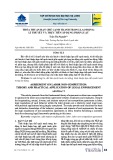




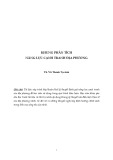

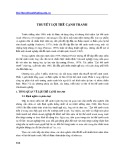
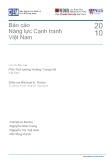
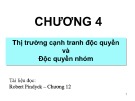


![Bài tập Kinh tế vi mô kèm đáp án [chuẩn nhất]](https://cdn.tailieu.vn/images/document/thumbnail/2025/20250923/thaovu2k5/135x160/19561758679224.jpg)












